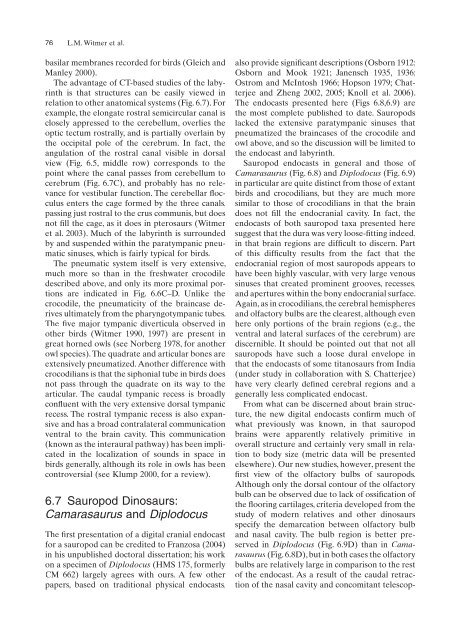Witmer, L. M., R. C. Ridgely, D. L. Dufeau, and M. C.
Witmer, L. M., R. C. Ridgely, D. L. Dufeau, and M. C.
Witmer, L. M., R. C. Ridgely, D. L. Dufeau, and M. C.
You also want an ePaper? Increase the reach of your titles
YUMPU automatically turns print PDFs into web optimized ePapers that Google loves.
76 L.M. <strong>Witmer</strong> et al.<br />
basilar membranes recorded for birds (Gleich <strong>and</strong><br />
Manley 2000).<br />
The advantage of CT-based studies of the labyrinth<br />
is that structures can be easily viewed in<br />
relation to other anatomical systems (Fig. 6.7). For<br />
example, the elongate rostral semicircular canal is<br />
closely appressed to the cerebellum, overlies the<br />
optic tectum rostrally, <strong>and</strong> is partially overlain by<br />
the occipital pole of the cerebrum. In fact, the<br />
angulation of the rostral canal visible in dorsal<br />
view (Fig. 6.5, middle row) corresponds to the<br />
point where the canal passes from cerebellum to<br />
cerebrum (Fig. 6.7C), <strong>and</strong> probably has no relevance<br />
for vestibular function. The cerebellar flfloc-<br />
culus enters the cage formed by the three canals,<br />
passing just rostral to the crus communis, but does<br />
not fill fi the cage, as it does in pterosaurs (<strong>Witmer</strong><br />
et al. 2003). Much of the labyrinth is surrounded<br />
by <strong>and</strong> suspended within the paratympanic pneumatic<br />
sinuses, which is fairly typical for birds.<br />
The pneumatic system itself is very extensive,<br />
much more so than in the freshwater crocodile<br />
described above, <strong>and</strong> only its more proximal portions<br />
are indicated in Fig. 6.6C–D. Unlike the<br />
crocodile, the pneumaticity of the braincase derives<br />
ultimately from the pharyngotympanic tubes.<br />
The fi five<br />
major tympanic diverticula observed in<br />
other birds (<strong>Witmer</strong> 1990, 1997) are present in<br />
great horned owls (see Norberg 1978, for another<br />
owl species). The quadrate <strong>and</strong> articular bones are<br />
extensively pneumatized. Another difference with<br />
crocodilians is that the siphonial tube in birds does<br />
not pass through the quadrate on its way to the<br />
articular. The caudal tympanic recess is broadly<br />
confl fluent<br />
with the very extensive dorsal tympanic<br />
recess. The rostral tympanic recess is also expansive<br />
<strong>and</strong> has a broad contralateral communication<br />
ventral to the brain cavity. This communication<br />
(known as the interaural pathway) has been implicated<br />
in the localization of sounds in space in<br />
birds generally, although its role in owls has been<br />
controversial (see Klump 2000, for a review).<br />
6.7 Sauropod Dinosaurs:<br />
Camarasaurus <strong>and</strong> Diplodocus<br />
The fi first<br />
presentation of a digital cranial endocast<br />
for a sauropod can be credited to Franzosa (2004)<br />
in his unpublished doctoral dissertation; his work<br />
on a specimen of Diplodocus (HMS 175, formerly<br />
CM 662) largely agrees with ours. A few other<br />
papers, based on traditional physical endocasts,<br />
also provide signifi ficant<br />
descriptions (Osborn 1912;<br />
Osborn <strong>and</strong> Mook 1921; Janensch 1935, 1936;<br />
Ostrom <strong>and</strong> McIntosh 1966; Hopson 1979; Chatterjee<br />
<strong>and</strong> Zheng 2002, 2005; Knoll et al. 2006).<br />
The endocasts presented here (Figs 6.8,6.9) are<br />
the most complete published to date. Sauropods<br />
lacked the extensive paratympanic sinuses that<br />
pneumatized the braincases of the crocodile <strong>and</strong><br />
owl above, <strong>and</strong> so the discussion will be limited to<br />
the endocast <strong>and</strong> labyrinth.<br />
Sauropod endocasts in general <strong>and</strong> those of<br />
Camarasaurus (Fig. 6.8) <strong>and</strong> Diplodocus (Fig. 6.9)<br />
in particular are quite distinct from those of extant<br />
birds <strong>and</strong> crocodilians, but they are much more<br />
similar to those of crocodilians in that the brain<br />
does not fi fill<br />
the endocranial cavity. In fact, the<br />
endocasts of both sauropod taxa presented here<br />
suggest that the dura was very loose-fitting fi indeed,<br />
in that brain regions are difficult fi to discern. Part<br />
of this diffi ficulty<br />
results from the fact that the<br />
endocranial region of most sauropods appears to<br />
have been highly vascular, with very large venous<br />
sinuses that created prominent grooves, recesses,<br />
<strong>and</strong> apertures within the bony endocranial surface.<br />
Again, as in crocodilians, the cerebral hemispheres<br />
<strong>and</strong> olfactory bulbs are the clearest, although even<br />
here only portions of the brain regions (e.g., the<br />
ventral <strong>and</strong> lateral surfaces of the cerebrum) are<br />
discernible. It should be pointed out that not all<br />
sauropods have such a loose dural envelope in<br />
that the endocasts of some titanosaurs from India<br />
(under study in collaboration with S. Chatterjee)<br />
have very clearly defined fi cerebral regions <strong>and</strong> a<br />
generally less complicated endocast.<br />
From what can be discerned about brain struc-<br />
ture, the new digital endocasts confirm fi much of<br />
what previously was known, in that sauropod<br />
brains were apparently relatively primitive in<br />
overall structure <strong>and</strong> certainly very small in relation<br />
to body size (metric data will be presented<br />
elsewhere). Our new studies, however, present the<br />
first fi view of the olfactory bulbs of sauropods.<br />
Although only the dorsal contour of the olfactory<br />
bulb can be observed due to lack of ossification fi of<br />
the fl<br />
ooring cartilages, criteria developed from the<br />
study of modern relatives <strong>and</strong> other dinosaurs<br />
specify the demarcation between olfactory bulb<br />
<strong>and</strong> nasal cavity. The bulb region is better preserved<br />
in Diplodocus (Fig. 6.9D) than in Camarasaurus<br />
(Fig. 6.8D), but in both cases the olfactory<br />
bulbs are relatively large in comparison to the rest<br />
of the endocast. As a result of the caudal retraction<br />
of the nasal cavity <strong>and</strong> concomitant telescop-

















